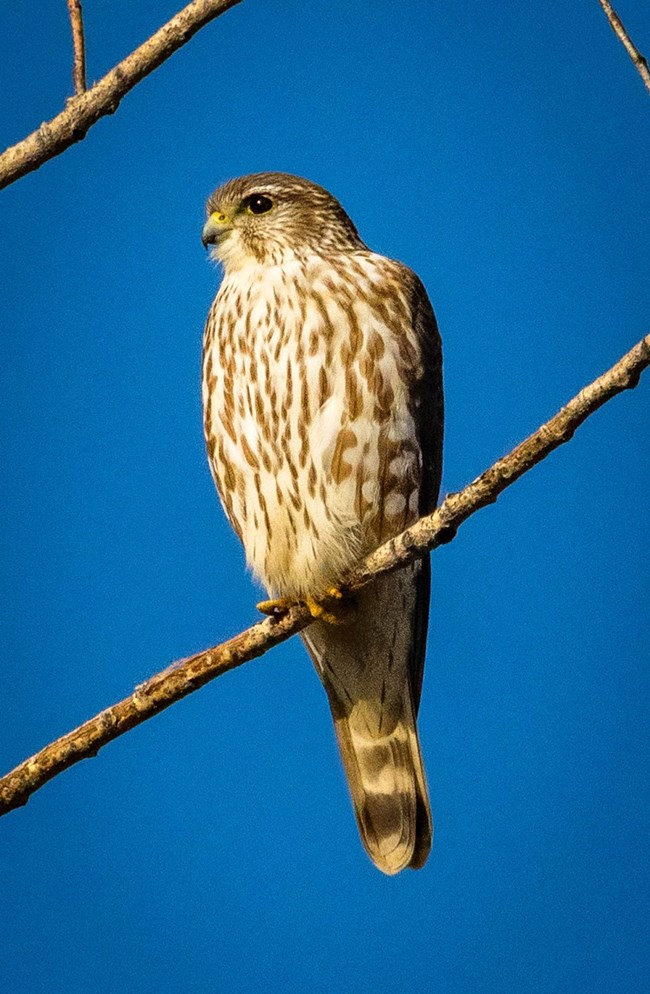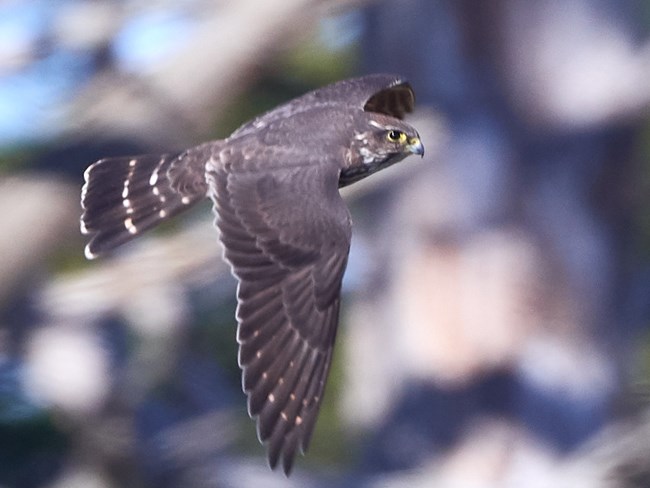Last updated: January 31, 2022
Article
Merlin

Nick Viani
General Description
A lucky find for winter birdwatchers in southern Oregon and northern California is a small but fierce falcon – the merlin (Falco columbarius). Slightly larger than the robin-sized American kestrel (Falco sparverius), a merlin has relatively dark streaking on its breast, a solid dark back, and a thinly banded tail. Merlins are sexually dimorphic, meaning that males and females differ in form. Males have a darker, sometimes bluish back compared with the female’s brown back, and, like many raptors, males are smaller than females. Both sexes lack the bold mustache stripes on the face of kestrels, and unlike kestrels, merlins don’t occur in this region year-round.
Merlins, in the falcon family (Falconidae), are commonly known as “pigeon hawks” because they resemble a pigeon in flight. A careful look, however, reveals the classic long tail and pointed wings of a falcon.

Frank D Lospalluto CC BY-NC-ND 2.0.
Habitat and Distribution
Merlins are divided into 10 subspecies across North America and Eurasia. All three North American subspecies may be seen during the winter or migration in the western US, though the taiga subspecies (Falco columbarius columbarius) is the most likely to be seen in southern Oregon and northern California.
Breeding habitat, predominantly in the northern, colder parts of the Northern Hemisphere, is typically open forest and woodland. This provides trees for nesting and open areas for hunting. Wintering habitat may include more open areas, such as grasslands, coastal marshes, and tidal flats, where merlins hunt small shorebirds. Merlins have increasingly occupied urban sites in Canada and northern US, presumably drawn to the plentiful songbird supply.
Diet
Merlins hunt small to medium-sized birds such as sparrows, waxwings, larks, and small shorebirds, like the least sandpiper (Calidris minutilla). House sparrows (Passer domesticus) are frequent prey in urban areas.
A common foraging strategy is to scan for prey from a perch and then launch a short, fast flight to catch it in mid-air. If unsuccessful on the first attack, the merlin may keep after its prey with a series of short stoops, known as “tail-chasing.” Other times, the merlin and prey may circle higher and higher in a chase known as “ringing flights.” Merlin pairs have been observed to hunt cooperatively, where one flies towards a flock of birds to flush them into the other’s line of attack.They may also take nestling birds directly from the nest.
Depending on conditions, birds are not the only prey for this agile flyer. They hunt small rodents, reptiles, and bats, and also catch insects. (Fledgling merlins are especially fond of dragonflies.)
Reproduction
Merlins breed at two years old, though some start as yearlings. Most North American subspecies are migratory to some degree and return to their breeding grounds in the northern US and Canada by March–April. Courtship involves elaborate flight displays, including steep dives, rolling from side to side, and wing fluttering. To initiate copulation, a male or female may bow, spread its tail, and utter a soft vocalization, similar to the peregrine falcon (Falco peregrinus).
Merlins do not build nests. They typically use old corvid or hawk nests in trees. The female lays a clutch of 3–6 short, elliptical eggs with reddish-brown markings. She incubates them with some help from the male for about 30 days until hatching. Males guard the nest vigilantly, especially against corvid predators (crows and jays). Nestlings fledge after about a month, and then spend the next several weeks near the nest, dependent on the adults.
Fun Fact
Catherine the Great and Mary Queen of Scots sport hunted with merlins in Europe.
Conservation
Like the peregrine falcon and other raptors, merlin populations crashed during the 1960s DDT era from organochlorine-based contamination. Though merlins still carry some DDE (a derivative of DDT) load, their populations have largely recovered and are expanding into urban areas.
Where to See
Merlins are rare or uncommon migrants in all Klamath Network parks except for Oregon Caves National Monument and Preserve.
More Information

Download a pdf of this article.
Prepared by Sonya Daw
NPS Klamath Inventory & Monitoring Network
Southern Oregon University
1250 Siskiyou Blvd
Ashland, OR 97520
Featured Creature Edition: January 2022
Thumbnail image credit: Frank Lospalluto CC BY-NC-ND 2.0.
